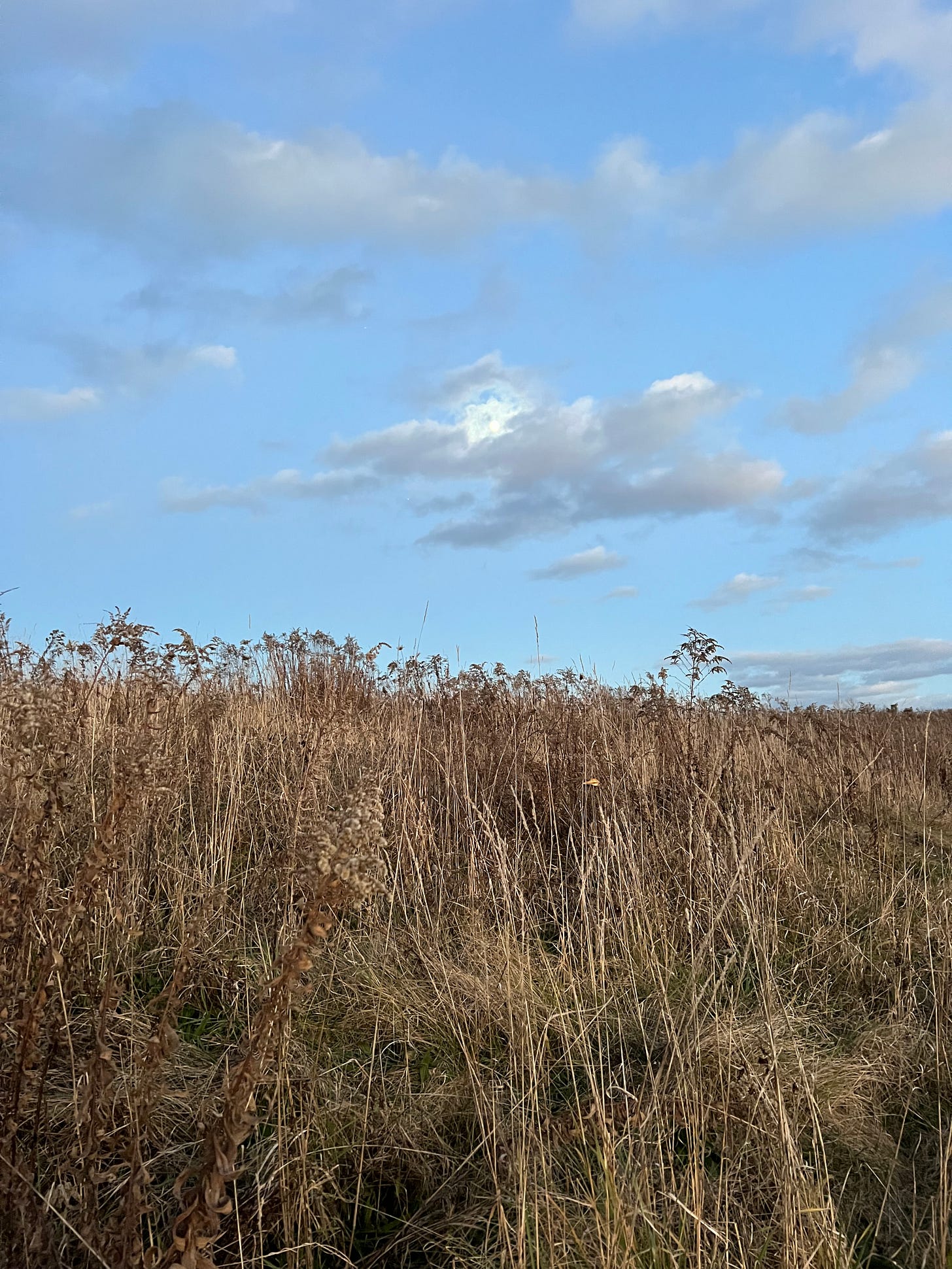So you want a high tunnel for your farm? Here's what I learned in a Cornell course this week.
The USDA offers a Free High Tunnel Initiative that piqued my interest at the end of 2024. I enrolled in an intermediate Cornell Small Farms course to learn more.
I started my second course with Cornell’s Small Farms Program this week to learn more about high tunnels in regards to my farm. There was so much invaluable information packed into this first lesson that I found myself wanting to come on here and share what I have learned with you all.
Since the USDA offers a Free High Tunnel Initiative (managed through their EQIP program - the same one I am in for conservation grant funds right now), more people than ever are considering this growing structure for their current, or future, farm.
High tunnels can be incredible agricultural assets, considering they do the following:
extend growing seasons, which is a game changer if you live somewhere like Upstate NY (where I am)
speed up growth of crops
protects plants from extreme heat, cold, and pests
allows farmers to grow crops that aren’t able to thrive naturally in that setting
However, I also learned there are some drawbacks, or more so, intense maintenance and management requirements that might not make this option something that vibes well with a solo farmer (hi, me).
The beauty of this farming revolution is that no two farms need to be the same. What may work for me, may not work for you, and vice versa. Our country, and our soil, desperately needs people to start small-scale farms again, pulling us away from the massive monoculture farming that has resulted in pesticide-soaked food, nutrient-deficient soil, and biodiversity reduction.
A high tunnel may be that solution for you! Allow me to share what I have learned.
High tunnels: site selection
Location, location, location. That’s what my instructors drilled home this week. Site selection for the high tunnel can make-or-break the entire experience. There are good sites, and there are very, very bad sites. Here’s what you need to know:
Light: it’s ideal for the tunnel to face east/west for more sunlight exposure. HOWEVER, if you live somewhere that’s windy (I do), north/south will be your only option for keeping the tunnel secure.
Wind: if your site is windy, you will need deep ground bolts/anchors to secure the tunnel. Anti-flap straps can be added as well. It can benefit you to build near a tree-line that breaks the wind, but not so close that the trees shade the high tunnel.
Temperature: high tunnels can have the plastic on the sides of the tunnel rolled up/down depending the temperature inside the tunnel. While it was only 39 degrees here the other day, one instructor clocked 85 degrees inside the tunnel. They needed to immediately raise the plastic to let in air flow, for example.
Soil: well-drained soil that is NOT addicted to tillage is a MUST. You want to start off with the very best ground you can give it.
Topography: it is critically important that you do not place your tunnel in an area that floods. Site work may be needed to raise the tunnel up 6 inches to prevent flooding. French drains can be added as well to divert rainwater away from the tunnel.
Snow: if you live somewhere it snows, check that the tunnel kit has a snow load rating for your climate. If 12-inches of snow ends up on top of the tunnel, that is hundreds to thousands of pounds on top of your tunnel. Tunnel design, like a gothic pointed roof, matters in this case (gothic is best for areas where it snows). Trusses need to also be added to the kit to protect against snow load.
Bonus tip: do NOT over-fertilize the land inside the tunnel. The instructors said there is an epidemic of this right now. If the land is poisoned with too many nutrients, you may have to move your tunnel, which can be expensive.
How are high tunnels permitted?
According to New York State, high tunnels are considered to be temporary structures. Municipalities have the ability to regulate the setback, however. In my town, the setback for a temporary structure is 75-feet from the main road or bordering properties.
This can vary by county and state, so please check with your town to learn how they define a high tunnel before purchasing one.
High tunnel styles
High tunnels are not greenhouses. They are a metal framed structure wrapped in plastic. There are a few different styles to choose from:
Caterpillar/hoop house style: these are moveable, used mainly in summer, and harder to ventilate. These are the cheapest option, and probably not going to help anyone in a colder climate.
Quonset hoop house: the width is max 24-feet. These are smaller than a regular tunnel style - some can be moved, some cannot. They are limited, again, when compared to the traditional gothic style.
Gothic/traditional high tunnel: these are best for shedding snow and come in widths of 24 to 30 feet. They usually measure 48 or 96 feet long and use trusses to support the roof.
As for the plastic… this is where they lost me. The high tunnel plastic needs to be replaced every four-to-six years depending on how the tunnel does in the changing temps and snow. This costs around $1,000 to $2,000 every time it is replaced, and unfortunately, there is no way to recycle the plastic at this time.
The instructors did note that double-layer plastic is better for wind and snow load, and of course, more expensive.
Weed barrier fabric can be laid on the perimeter of the tunnel to prevent headaches in the future as well.
What is the best size for a high tunnel?
In this case, the instructors said that bigger is better for high tunnels. Bigger tunnels come with more ventilation, which is key for keeping the plants happy and the fungal overgrowth at bay. More space helps the tunnel regulate the temperature, which can spike quickly.
They did note that high tunnel upkeep is more frequent than people believe. Someone needs to be onsite pretty much every other day to check if the tunnel is flooding, if any of the plastic is punctured or collapsing, and most importantly, to manage the temperature. Spikes in temperatures can kill the plants inside, which is why approaching this structure as something of a ‘side hustle’ might not be the best move.
On the USDA’s High Tunnel Initiative
I have spoken with the USDA about their initiative, having previously considered a high tunnel. The program is designed to cover 100% of the funds IF you keep the build to $7/square foot or less. However, high tunnel kits do not usually come with the doors/panels that close in the structure.
Therefore, you may have to foot some of the bill to get the tunnel where you want it. My office said they offer 50% financial support upfront, and 50% when the build is done. Due to changes at the federal government right now, I would speak extensively with your office before committing to this, and understand that things may be delayed now, etc. It’s always up to all of us to do our due diligence!
Should you get one?
I am by no means trying to discourage anyone from doing this. As a solo, 5 foot 3 inch tall female, it appears the maintenance and upkeep of one of these tunnels is more than I could handle. Rolling the plastic up and down every day, the instructors said, can be laborious. Removing snow from the top of the tunnels requires two people and some ropes at times. Installing doors, changing the plastic, etc. may be more helpful if the owner has access to construction equipment, or is probably twice my height/size.
The Cornell instructors concluded by saying this is not a structure you want to skimp on when it comes to money. Improperly installed high tunnels can break, bend, take off in the wind, collapse, and flood. If you are going to invest in one of these, do it with a reputable company and go for the kit that is designed to withstand the weather in your area.
But all of that aside, if you’re committed to your tunnel and ready to farm year round, then you will find one of these to change the game for you. Being able to sell fresh produce in mid-February in the Northeast, for example, will fetch you a profitable price tag. Just know that managing one of these is not necessarily as physically easy as they might appear.
I have more classes to go in this course, so if you all like this topic, let me know and I will keep writing about it! I cover all things land loans, starting a farm from scratch, developing raw land, doing this all mainly solo, without a tractor, and working with the Amish here on my Substack.
As this is one of my free articles, here is my ‘buy me some seeds’ profile if you feel inclined.
All funds raised through this link will be 100% used to buy native seeds, plants, and my greater conservation work at the farm.
Thank you all: https://buymeacoffee.com/alexfasulo.
Follow along!









Thank you!
Now we need to get them to do a similar program for the smaller guys. Let's see some funding go into getting people set up with https://growingspaces.com/ -- longer lifespan and easier maintenance. Automatic ventilation with solar panel fans and beezwax hinges.
thank you for this update..temperature rated floating row covers are also used to extend one’s growing seasons and methinks more compatible for crop rotation;winter cover crops which augments soil
health only within reason within this changing world…
a key comment you provided is a disturbing use overfertilaton which ruins soils micro biomes
sometimes there is more merit in thinking small and more compatible alternatives as you accommodate and work out issues